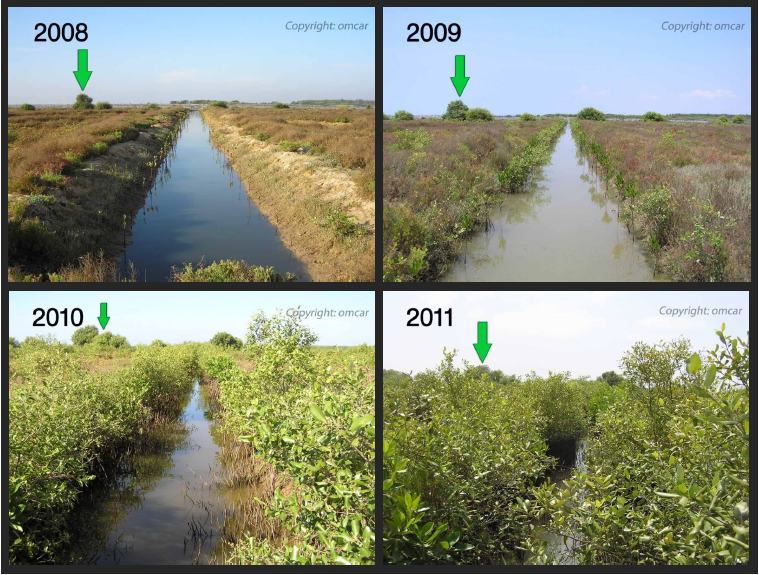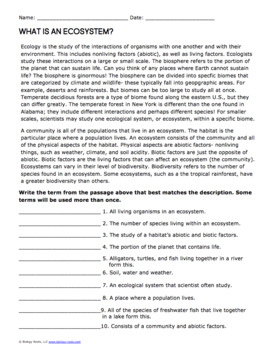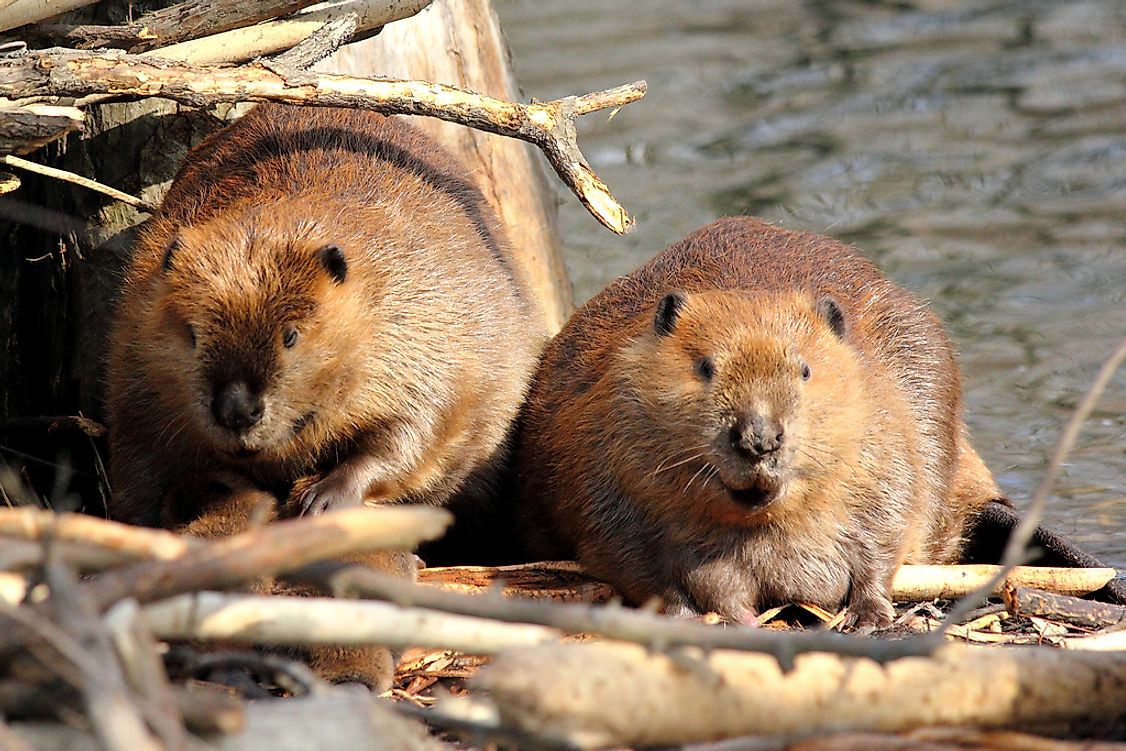Topic what is an ecosystem: Discover the wonders of ecosystems, nature"s intricate networks that sustain life on Earth. From forests to oceans, learn how these dynamic systems support biodiversity, regulate climate, and provide essential services to humanity.
Table of Content
- What are the components that make up an ecosystem?
- Definition and Importance of Ecosystems
- Types of Ecosystems: Aquatic, Terrestrial, and Artificial
- Key Components: Biotic and Abiotic Elements
- Energy Flow and Nutrient Cycles in Ecosystems
- Interactions Among Organisms: Food Chains and Webs
- YOUTUBE: What is an Ecosystem
- Role of Ecosystems in Climate Regulation and Carbon Sequestration
- Human Impact on Ecosystems: Conservation and Restoration Efforts
- Ecosystem Services: Benefits to Humanity and Biodiversity
- Emerging Challenges: Climate Change and Habitat Loss
- Future Directions in Ecosystem Research and Management
What are the components that make up an ecosystem?
An ecosystem is made up of various components that work together to create a balanced and sustainable environment. The key components of an ecosystem include:
- 1. Abiotic factors: These are non-living components such as soil, water, air, temperature, sunlight, and minerals that provide the physical environment for living organisms.
- 2. Biotic factors: These are living organisms within the ecosystem, including plants, animals, fungi, and microorganisms that interact with each other and with the abiotic factors.
- 3. Producers: These are autotrophic organisms, such as plants, algae, and some bacteria, that produce food through photosynthesis for themselves and other organisms in the ecosystem.
- 4. Consumers: These are heterotrophic organisms, including herbivores, carnivores, omnivores, and decomposers, that feed on producers and other consumers to obtain energy.
- 5. Decomposers: These are organisms, such as fungi and bacteria, that break down dead organic matter, recycling nutrients back into the ecosystem.
- 6. Food chains and food webs: These represent the transfer of energy and nutrients within the ecosystem, showing the interconnectedness of different organisms.
- 7. Habitat: This is the specific environment where an organism or a community of organisms lives, providing shelter, food, and other resources.
READ MORE:
Definition and Importance of Ecosystems
An ecosystem is a complex network of living organisms (biotic factors) and the non-living (abiotic factors) elements that interact within a specific area, creating a system through which energy flows and nutrients cycle. These interactions form the foundation for the rich biodiversity that sustains life on Earth.
The importance of ecosystems cannot be overstated. They provide essential services that support life, including purifying air and water, pollinating crops, controlling pests, cycling nutrients, and providing raw materials and resources for human use. Ecosystems also play a crucial role in regulating the climate, storing carbon, and protecting against natural disasters like floods and storms.
- Biodiversity Support: Ecosystems are home to a vast array of species, each playing a specific role that contributes to the stability and productivity of the environment.
- Climate Regulation: Through processes like photosynthesis and carbon sequestration, ecosystems help to regulate the Earth"s climate, mitigating the effects of global warming.
- Water Regulation and Purification: Ecosystems regulate the hydrological cycle, ensuring the availability of fresh water while filtering pollutants, thereby maintaining water quality.
- Soil Formation and Protection: Ecosystems contribute to soil formation and prevent soil erosion, which is vital for agriculture and our food supply.
- Economic Benefits: Many economies rely on the goods and services provided by ecosystems, including tourism, fishing, and timber.
- Mental and Physical Health: Ecosystems offer recreational spaces and opportunities for stress relief and physical activity, contributing to overall well-being.
Understanding and preserving ecosystems is critical for maintaining the planet"s health, biodiversity, and the well-being of all its inhabitants. By recognizing their value, we can work towards a more sustainable interaction with our natural world.
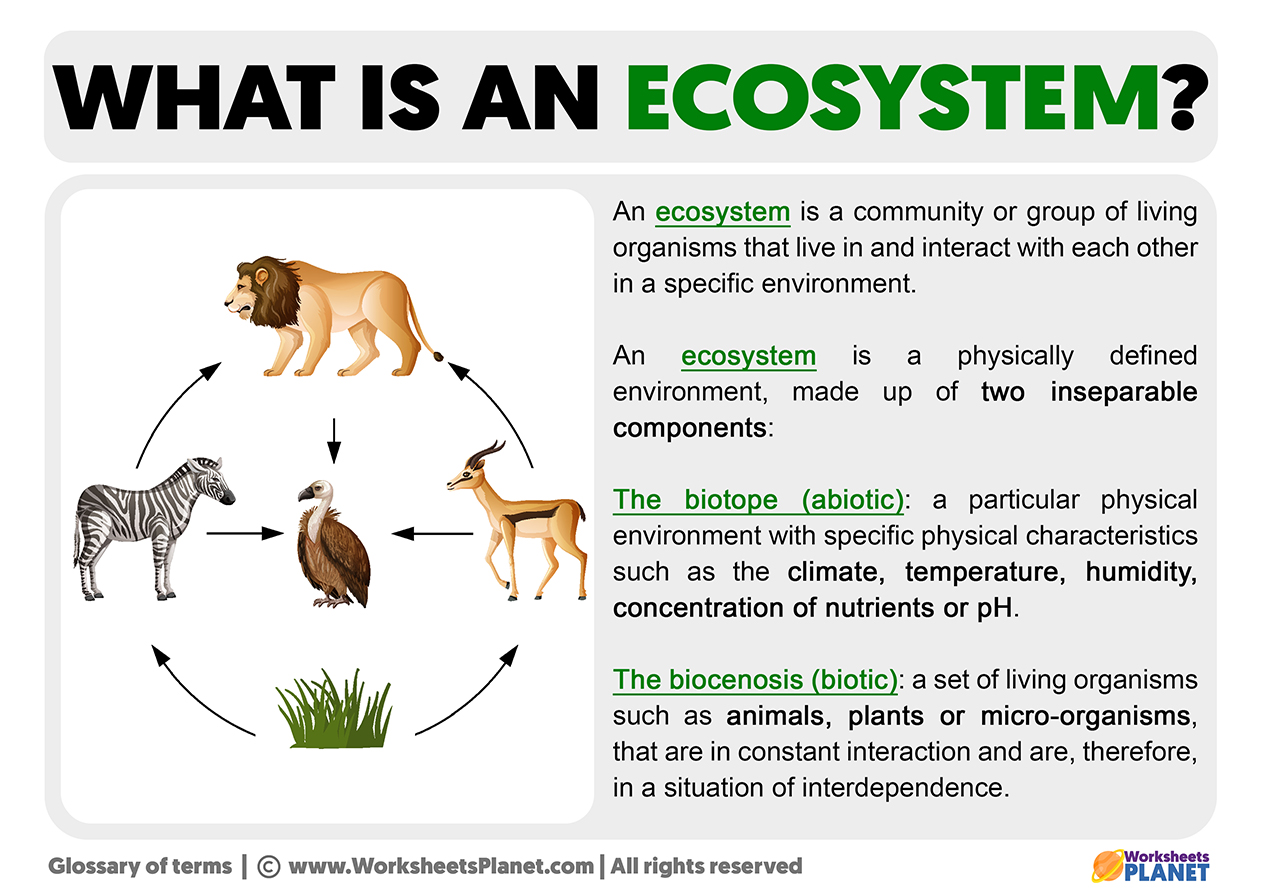
Types of Ecosystems: Aquatic, Terrestrial, and Artificial
Ecosystems are broadly classified into three main types: aquatic, terrestrial, and artificial. Each type supports unique habitats, species, and interactions, showcasing the incredible diversity of life on Earth.
- Aquatic Ecosystems: These are water-based ecosystems and are subdivided into freshwater (rivers, lakes, and ponds) and marine (oceans, seas, and coral reefs) ecosystems. Aquatic ecosystems are vital for supporting a vast array of aquatic life, regulating water cycles, and providing resources like fish.
- Terrestrial Ecosystems: Located on land, these ecosystems range from dense forests and grassy plains to deserts and mountains. Terrestrial ecosystems are characterized by the wide variety of life they support, influenced by factors such as climate, soil type, and altitude.
- Artificial Ecosystems: Created by humans, these include urban environments, agricultural lands, and artificial lakes. Despite being man-made, these ecosystems can support diverse communities of plants, animals, and microorganisms, though they often require more management to maintain ecological balance.
Understanding the characteristics and dynamics of each ecosystem type is crucial for conservation efforts and ensuring the sustainability of our planet"s natural resources and biodiversity.
Key Components: Biotic and Abiotic Elements
Ecosystems are made up of biotic and abiotic components that interact in complex ways to create a balanced environment. Understanding these elements is crucial for studying ecosystem dynamics and their impacts on biodiversity and ecosystem services.
- Biotic Elements: These are the living components of an ecosystem, including plants, animals, fungi, and microorganisms. Biotic elements play various roles as producers, consumers, and decomposers, forming a web of life that supports the flow of energy and cycling of nutrients.
- Abiotic Elements: These are the non-living physical and chemical factors that influence the ecosystem, such as sunlight, temperature, water, minerals, and soil. Abiotic elements determine the conditions under which the biotic elements can live, grow, and reproduce.
Together, biotic and abiotic elements create the conditions for ecosystems to function and thrive. The interdependence of these elements highlights the importance of preserving both to maintain the health and sustainability of ecosystems worldwide.

Energy Flow and Nutrient Cycles in Ecosystems
The seamless flow of energy and the cycling of nutrients are fundamental processes that sustain ecosystems. These processes ensure that energy is transferred between organisms, and nutrients are recycled, supporting the complex web of life.
- Energy Flow: Energy in ecosystems flows in a linear direction, starting from the sun to producers (autotrophs) and then to various levels of consumers (heterotrophs). This flow is depicted through food chains and webs, illustrating how energy is transferred from one organism to another. Energy is lost as heat at each trophic level, following the Second Law of Thermodynamics.
- Nutrient Cycles: Unlike energy, nutrients are recycled within ecosystems. Key nutrient cycles include the carbon, nitrogen, phosphorus, and water cycles. These cycles involve the movement of elements from the physical environment to living organisms and back, ensuring that essential nutrients are available to sustain life.
Understanding energy flow and nutrient cycles helps explain how ecosystems function, the interdependence of species, and the impacts of human activities on natural processes. These insights are crucial for conservation and sustainable management of ecosystems.
Interactions Among Organisms: Food Chains and Webs
Interactions among organisms within ecosystems are complex and vital for the survival of species. Food chains and webs illustrate these interactions by showing how energy and nutrients flow from one organism to another.
- Food Chains: A food chain is a linear sequence that shows how nutrients and energy are passed from one organism to another. It begins with primary producers (typically plants) that create energy via photosynthesis, followed by primary consumers (herbivores) that eat the producers, and then secondary and tertiary consumers (carnivores or omnivores) that eat other animals.
- Food Webs: More complex than food chains, food webs illustrate the network of interconnected food chains within an ecosystem. They demonstrate how different species are connected through multiple feeding relationships, highlighting the ecosystem"s biodiversity and the interdependence of organisms.
These interactions ensure the transfer of energy and recycling of nutrients, supporting ecosystem stability and resilience. Understanding food chains and webs is crucial for grasping the importance of each species and the potential impacts of their loss on ecosystem health.
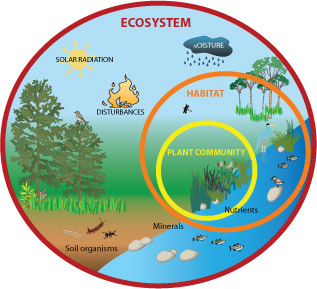
What is an Ecosystem
Experience the beauty and wonder of our planet\'s intricate ecosystem in this captivating video. Discover the harmony of nature and the importance of preserving it for future generations.
Role of Ecosystems in Climate Regulation and Carbon Sequestration
Ecosystems play a crucial role in regulating the Earth"s climate and acting as carbon sinks, thereby mitigating the effects of climate change. Through the processes of photosynthesis, respiration, and decomposition, ecosystems control the concentration of greenhouse gases in the atmosphere.
- Photosynthesis: Plants and other photosynthetic organisms capture carbon dioxide (CO2) from the atmosphere and convert it into organic carbon, releasing oxygen in the process. This not only reduces CO2 levels but also supports life by producing oxygen.
- Carbon Sequestration: Forests, oceans, and soils are vital carbon sinks. They store carbon in biomass and soil, removing it from the atmosphere. Preserving and restoring these ecosystems are essential strategies for carbon sequestration and climate mitigation.
- Climate Regulation: Ecosystems regulate climate by controlling local and global temperatures, humidity, and precipitation patterns. For example, forests influence rainfall and cool temperatures through transpiration, while oceans absorb and distribute solar energy, regulating climate.
The conservation and restoration of ecosystems are pivotal in combating climate change. Protecting natural habitats, reforesting, and practicing sustainable land management are ways to enhance ecosystems" ability to regulate climate and sequester carbon, benefiting the planet and future generations.
Ecosystems Episode 1: What is an Ecosystem
Dive into the latest episode of this exciting series, filled with surprises, twists, and unforgettable moments. Join the adventure and get ready to be entertained from start to finish.
Human Impact on Ecosystems: Conservation and Restoration Efforts
Human activities have significantly impacted ecosystems worldwide, leading to habitat destruction, pollution, climate change, and loss of biodiversity. However, through conservation and restoration efforts, we can mitigate these impacts and support ecosystem resilience.
- Conservation Initiatives: These include establishing protected areas such as national parks and wildlife reserves to safeguard habitats and preserve biodiversity. Conservation also involves sustainable management practices that balance human needs with the health of ecosystems.
- Restoration Projects: Restoration efforts aim to return degraded ecosystems to their natural state. Activities include reforestation, wetland restoration, coral reef rehabilitation, and removing invasive species to help ecosystems recover their functions and services.
- Community Involvement: Engaging local communities in conservation and restoration efforts is crucial. Community-based approaches ensure that conservation strategies are culturally appropriate, socially beneficial, and more sustainable in the long term.
- Policy and Legislation: Effective environmental policies and regulations are essential to protect ecosystems. This includes laws to reduce pollution, manage natural resources sustainably, and combat climate change by reducing greenhouse gas emissions.
By understanding the impacts of our actions on ecosystems and implementing comprehensive conservation and restoration strategies, we can ensure the health and sustainability of our planet for future generations.

Ecosystem Services: Benefits to Humanity and Biodiversity
Ecosystems provide a vast array of services that benefit humanity and maintain biodiversity, ensuring the health and sustainability of our planet. These services are often taken for granted but are crucial for our survival and well-being.
- Provisioning Services: These include the supply of food, fresh water, wood, fiber, and genetic resources. Ecosystems are the source of our most basic needs, from the food on our tables to the clothes we wear.
- Regulating Services: Ecosystems regulate climate, diseases, water purification, and pollination. They help mitigate natural disasters, such as floods and storms, and control the spread of pests and diseases.
- Supporting Services: These are fundamental processes like soil formation, nutrient cycling, and primary production. They support the provisioning and regulating services, making life on Earth possible.
- Cultural Services: Ecosystems provide recreational, aesthetic, and spiritual benefits. Natural landscapes are a source of inspiration and relaxation, and they play a part in cultural identity and community well-being.
Recognizing the value of ecosystem services is essential for sustainable development. By conserving ecosystems and their services, we support not only our current needs but also those of future generations, ensuring a healthy planet rich in biodiversity.
Emerging Challenges: Climate Change and Habitat Loss
As we move forward, ecosystems worldwide are facing significant challenges that threaten their health and sustainability. Climate change and habitat loss stand out as two of the most pressing issues, with far-reaching impacts on biodiversity, ecosystem services, and human well-being.
- Climate Change: Rising temperatures, changing precipitation patterns, and increased frequency of extreme weather events are altering ecosystems. These changes affect species distribution, migration patterns, and the timing of reproduction cycles, disrupting ecological balance.
- Habitat Loss: Driven by urbanization, agriculture, deforestation, and industrialization, habitat loss is the leading cause of biodiversity decline. It not only reduces the space available for species but also fragments ecosystems, making it harder for species to migrate, find food, and reproduce.
- Combating the Challenges: Addressing these challenges requires global cooperation and local action. Efforts include reducing greenhouse gas emissions, implementing sustainable land use practices, conserving remaining natural habitats, and restoring degraded ones. Awareness and education can also play a key role in driving change.
By tackling climate change and habitat loss, we can safeguard ecosystems and their services for future generations, ensuring a resilient and thriving planet.
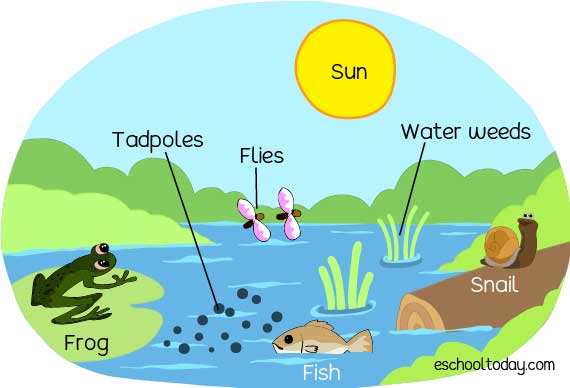
READ MORE:
Future Directions in Ecosystem Research and Management
The future of ecosystem research and management is poised to embrace innovative approaches and technologies to address the environmental challenges of our time. Advancements in this field are crucial for the conservation of biodiversity and the sustainability of ecosystem services.
- Integrated Ecosystem Management: A holistic approach that considers the complex interconnections within ecosystems and the human dimension. This strategy aims to balance conservation efforts with sustainable development needs.
- Technological Innovations: The use of remote sensing, drones, and artificial intelligence for monitoring ecosystems and biodiversity. These technologies offer precise data that can inform conservation strategies and track their effectiveness over time.
- Climate Change Adaptation: Developing strategies that enhance the resilience of ecosystems to the impacts of climate change. Research is focused on understanding how ecosystems can adapt to changing conditions and mitigating adverse effects.
- Community-based Conservation: Engaging local communities in the conservation process, recognizing their knowledge and making them stewards of their environment. This approach ensures the sustainability of conservation efforts and benefits local populations.
- Global Collaboration: Strengthening international cooperation to address cross-border environmental issues, such as climate change, biodiversity loss, and pollution. Shared knowledge and resources can lead to more effective ecosystem management practices.
As we advance, the integration of science, policy, and community engagement will be key to effective ecosystem management. By fostering innovation and collaboration, we can ensure the health and vitality of the planet"s ecosystems for future generations.
Embarking on the exploration of ecosystems reveals the intricate beauty of our planet"s life-support systems. Understanding ecosystems is key to fostering a sustainable future, where nature and humanity thrive in harmony.


